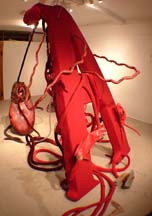Big Books of American Literature: Alchemies of Mind
Day 17: Tuesday, March 21, 2006
(second third of) The Scarlet Letter
by Thursday: finish the novel
next Tuesday: guest lecture by Amelia Rorty (Harvard University)
by Wednesday, 3/29 (a week from tomorrow): paper on The Scarlet Letter is due
Back to High School....

"I used to love to read, but...I'd lost that....The way these books were taught in my high school always came out on the overly moralistic side....I'm so glad I've gotten the chance to change my opinion." ( Laci)
"I've always seen it as a book drowned in...shame and guilt--I feel saturated with them more and more with every page I read--but everything I read/hear about it is more like it's a book about shedding those labels/ideas." (Amy)
"there is an even more limited view of literature we take in high school (that is, concidering how limited our life experiences are at that point....), so much of our opinions of texts have to do with where they were placed and how they were taught." (Jessica)
Today's Project: Compare and Converse
I. Two passages to compare:
"'There is no path to guide us out of this dismal maze!'...'By thy first step awry, thou didst plant the germ of evil; but since that moment, it all been a dark necessity...it is our fate.'" (Hester Prynne and Roger Chillingworth in conversation, Chapter 14 of The Scarlet Letter, pp. 125-126)
"I don't believe in character. I believe in the effect of the immediate impact of environment and situation on people's behavior"....You can make a difference, you have the capacity to change...."To be someone who does not believe in the power of the situation is to be a defeatist about the world...And that I can't abide." (Malcolm Gladwell, NYTimes profile 2/5/06)
II. A theory of comparison (from the teacher)
From the upcoming search for an Americanist in the BMC English Department
Shelley Fisher Fishkin, "Crossroads of Cultures: The Transnational Turn in American Studies (November 12, 2004):
comparative analysis of particular national and transnational histories reveals phenomena that strike one society as "natural" or "given" to be, instead, highly constructed and contingent.
We cannot predict which conversations...will plant seeds that will bear fruit some day. What we can do is remain open to.."the serendipity of scholarship" as we struggle to understand the transnational crossroads of cultures that confront us in American studies...and work against government policies that hamper the free flow of information...
Some insight from Biblical scholarship
(w/ thanks to Paul
Burgmayer, chem ph.d, h.s. math instructor and
friend)
Burton Mack, Who Wrote the New Testament? The Making of a
Christian Myth (HarperCollins, 1995):
It is an accidental by-product of the way the Bible combines two
different collections of writings, the Old and the New Testaments
[that] forms a kind of equation for solving theoretical problems and
produces a kind of grammar for thinking about human situations...it
automatically activates cognitive functions...basic for any and all
human thought....
The balance between the old and the new sets up an equation of
comparison and contrast...fundamental modes of classifying things and
thinking about them...some would say they are the fundamental
cognitive functions....The signs contained in the Old Testament need
to be read at two levels of signification in order to work in the
Christian equation....One must discover the latent significance of
Old Testament texts in order to mark their correlation with Christian
meanings. Thus one of the powers of the Bible is to force ironic
readings of Old Testament texts, in order to produce Christian
meanings...."meaning" is the sense of significance we experience when
we find it possible to correlate two different systems of signs
(Levi-Strauss)....
In the Old Testament a word or event has to refer to two different
orders of discourse synchronically, or at the same time. The paschal
lamb is first the Jewish paschal lamb, but it "really" refers to
Jesus Christ as God's eternal intention. The double meaning of the
words and events in the New Testament, on the other hand, is found in
their application to a then and a now....diachronic, except that it
is a matter of the same event taking place at two different times in
Christian history....the marvelous intermingling of the unique event
and its replication ( a contradiction in terms, to be sure), or the
sense of the incomparable Christ event as paradigmatic of the "novel"
and the "new" in every Christian's own experience,is also a product
of the Bible's cognitive equation....
The equation activates basic cognitive functions of comparison and
contrast, offers a very rich reservoir of narrative imagery, and
provides a lens for both the ironic and paradigmatic interpretation
of all human events, both then and now, simultaneously....the old-new
formula in the composition of the Bible has resulted in a
distinctively Christian mentality that views all
non-Christians as pre-Christian. This mentality includes an implicit
claim to know the truth about God, history, and the human situation
that other people do not know....the Biblical epic is based on a
worldview that is universalist in scope, monolinear in historical
imagination, a singular system in organic conception, hierarchical in
the location of power, dualistic in anthropology, and which has to
have miracles, breakthroughs, and other dramatic or divine moments of
rectification to imagine the adjustments that humans have to make
when life and social circumstances change....These features...are
no longer helpful as ideals in our multicultural world....
Early Christian history is a chapter in the larger history of human
social formation and mythmaking...born both of new ideas and of the
rearranging of traditional images already at
hand....Understanding those reasons lets us appreciate the mythmaking
of those early Christians even as we recognize that their reasons for
telling their stories are not good enough to be our reasons for
continuing to tell the stores just as they told them.
III. Suggestion regarding comparative practice (from a student)
(or--still mining those mid-semester evals...!):
Laura S.: I feel like we do a lot of...saying what we have to say without responding to others' ideas or letting them change our minds....I wish we were talking to each other more!
Let's try it
(i.e. conversing and comparing....)
A. Pair off and tell one another:
What did you make of Marc's presentation
and Gladwell's writing about emotion and intuition?
A few prompts/reminders:
from Marc:
emotions are part of our "evolutionary heritage,"
but we have the capacity to regulate them
our "appraisals of meaning" demonstrate the role of thinking in emotions:
--we can learn to "read" emotion (our own and others)
--examine our personal stake in an emotion
--ask what core relational themes underlie/strongly correlate with/cause each emotion
(i.e.: sadness from irreversible loss of something important;
happiness from making progress toward a goal;
anger from inconsideration/the experience of being demeaned or dissed)
--and we can change how we feel
from "The Gladwell Effect" (NYTimes profile 2/5/06):
"'People are experience rich and theory poor....people who are busy doing things...don't have opportunities to collect and organize their experiences and make sense of them....we pay too much attention to 'grand themes' and too little to 'fleeting moments'....Gladwell offers optimism through demystification: to understand how things work is to have control over them."
B. Quadruple up (think of this as an "exponential" conversation) to consider how useful these ideas are in reading the central portion of The Scarlet Letter

Four Portraits (Chillingworth, Dimmesdale, Prynne and Pearl)
From "Exposing Scarlet: A Visual Response to The Scarlet Letter,"
Boston Center for the Arts
Jump starts from
Adina:"it is possible to guess the end of the novel right from the beginning....one can often predict the ending of certain books such as mysteries from a formula apparent from the very beginning. We get better at this as we read more"--
Margaret: "What interests me is that they made this judgement of dislike, but then many have admited that, having actually begun Hester's story, they now like the book. Does this mean that their first judgement was inaccurate?....the letter A begins to take on different meanings so the snap judgement is no longer the intended one....Can a person's fist even change over time....?"
Erin: "I find it hard to believe that a relationship doesn't change over time. To contradict myself though...that first impression sticks deep in our hearts, maybe even subconsciously? "
Chris: "Is A for Anarchy?...she is redefining the community."
Some prompts/passages to focus on--
the characters of Pearl, of Hester, of Dimmesdale, of Chillingworth--
and of the relations between them
"She knew her deed had been evil; she could have no faith, therefore, that its result would be for good....The child could not be made amenable to rules. In giving her existence, a great law had been broken; and the result was a being, whose elements were...all in disorder; or with an order peculiar to themselves....It was as if she had been made afresh, out of new elements, and must perforce be permitted to...be a law unto herself. (Ch. 6, "Pearl," pp. 67-69; Ch. 10, "The Leech and his Patient, p. 99)
Mr. Dimmesdale was a true priest...with an order of mind that impelled itself powerfully along the track of a creed, and wore its passage continually deeper with the lapse of time...it would always be essential to his peace to feel the pressure of a faith about him, supporting, while it confined him within its iron framework. Not the less, however...did he feel the occasional relief of looking at the universe through the medium of another kind of intellect....It was as if a window were thrown open, admitting a freer atmosphere into the close and stifled study....But the air was too fresh and chill to be long breathed, with comfort...the Reverend Arthur Dimmesdale...was haunted either by Satan himself, or Satan's emissary, in the guise of old Roger Chillingworth....the people looked...to see the minister come forth out of the conflict, transfigured with glory. (Ch. 9, "The Leech," pp. 91, 95)
...as he proceeded, a terrible fascination, a kind of fierce, though still calm, necessity seized the old man...He now dug into the poor clergy man's heart, like a miner searching for gold; or, rather, like a sexton delving into a grave....He groped along as stealthily...as a thief entering a chamber where a man lies only half asleep ... He became...a chief actor, in the poor minister's interior world. He could play upon him as he chose. (Ch. 10, "The Leech and his Patient, pp. 95-96; Ch. 11, "The Interior of a Heart," p. 103)
...what was he?--a substance?--or the dimmest of all shadows?...a life so false as his..steals the pith and substance out of whatever realities there are around us....to the untrue man the whole universe is false--it is impalpable--it shrinks to nothing...and he himself...becomes a shadow....The only truth, that continued to give Mr. Dimmesdale a real existence on this earth, was the anguish in his inmost soul....when an individual discovers a revelation, addressed to himself alone...it could only be the symptom of a highly disordered mental state...extended his egotism over the whole expanse of nature, until the firmament itself should appear no more than a fitting page for his soul's history and fate..,,the minister, looking upward to the zenith...beheld...the letter A (Ch. 11, "The Interior of a Heart," pp. 105, 107, 113)
Hester was little accustomed, in her long seclusion from society, to measure her ideas of right and wrong by any standard external to herself....her life had turned, in a great measure, from passion and feeling, to thought. Standing alone in the world....she cast away the fragments of a broken chain. The world's law was no law for her mind....Hester Prynne...assumed a freedom of speculation...which our forefathers, had they known of it, would have deemed a deadlier crime than that stigmatized by the scarlet letter...a tendency to speculation...makes her sad. She discerns...such a hopeless task before her....the whole system of society is to be torn down, and built up anew. Then, the very nature of the opposite sex...is to be essentially modified...finally...she herself shall...undergo...a still mightier change....Hester Pryne...wandered without a clew in the dark labyrinth of mind (Ch. 13, "Another View of Hester," pp. 116, 119, 120)
C. Get into "octagonal" groups (of 8) to apply literary/critical theory to these passages
Consider Alison's observation-- "Two things are making the book pleasantly surprise me and disarming my prejudices: Hawthorne's wit and snappiness as a writer and his ability to give everything two conflicting sides....several painful layers"--
but also Laine's: "a lot of students here at Bryn Mawr could benefit from a little less thinking....we all tend to...over analyze way too much sometimes....we just process and process and process...."

"Hunger," 2004
From "Exposing Scarlet: A Visual Response to The Scarlet Letter"
Jonathan Arac on "The Politics of the Scarlet Letter":
the key to understanding the novel is not Puritanism, but the politics of 1850's
two years after the novel, Hawthorne published The Life of Franklin Pierce, an unequivocal endorsement of the Democratic candidate for president as an ideal combination of future and stability, "motion and regulation"
the "organization of inaction" of TSL takes its structure of conflicting values from the political impasse of the 1850s
it makes literature intransitive, useless, harmless
like UTC, TSL is propaganda-> NOT to change your life!
TSL gets hung up on the contradictions between passion and principle
it takes its keynote from Hawthorne's political position, esp. regarding slavery:
"Hawthorne did not favor slavery; he only urged that nothing be done about it....as one of those evils which Providence...will cause to vanish like a dream"...he saw the Civil War as a "horrible convulsion for that which might come by gradual and peaceful change"
action is intolerable; character takes its place
the point of the plot is to erase and undo all action
Dimmesdale's emotional wavering, like Pierce's political "trimming"-->
the politics of issueless patience

"Corporeal 'A'
From "Exposing Scarlet: A Visual Response to The Scarlet Letter"
Cf. Frederic Carpenter, "Scarlet A Minus,"
American Literature and the Dream
- orthodox believers say Hester was truly sinful/ her passion fatal flaw that caused tragedy
- romantic enthusiasts say social determinism caused the disaster: Hester's passions are good, and society is evil for condemning her
- Carpenter offers the mediation of transcendent idealism:
reading the novel with the help of the transcendentalists Emerson and Thoreau,
he argues that there is a higher law beyond tradition or romance,
that love is not romantically immoral nor blindly rebellious,
but that Hester sinned in putting romantic love ahead of ideal truth:
she sacrificed her own integrity by giving everything to her lover
traditional tragedy: result of individual imperfection
romantic tragedy: result of oppression of evil society
transcendental tragedy: result of conflict of values:
Dimmesdale's orthodox morality vs. Hester's dream of freedom
novel deeply confused:
Hawthorne allowed his imagination to create an idealist heroine,
but wouldn't allow his conscious mind to justify her ideals:
damned her for being romantic, immoral
the wilderness is the precondition of a new morality of freedom,
an authentic American dream of a new life,
but Hawthorne got afraid, placated his conscience, couldn't permit such freedom
So:
in Carpenter's version, the novel is about the frustrated desire
for transcendental freedom/individual integrity
in Arac's, it's about political inaction
What do you think??
Return to Forum
Return to Syllabus









